This isn’t the story about my first comic book, because that story doesn’t exist. For as long as I can remember, comic books have always been a part of my life. If I had to point to the first comic book that began my collection, I couldn’t do it. They were just always… there.
No, this is a story of my comic book collecting life through one of the most tumultuous periods of comic book history. I was born into some of the industry’s greatest heights and as I grew older I was around for some of its greatest lows. Throughout the 1990s, comic books exploded in popularity, eventually leading to a speculation boom and bust that took years to recover from. And I was there for all of it, albeit as a young and naive child, mostly unaware of what was happening around me.
A good chunk of this article is adapted from a research piece of mine from grad school, because yeah, I am that guy. While I will be covering the history of comic books in the 90s, it is in no way exhaustive. Even focusing on superhero comics alone, I realize that I am skimming history at best. In lieu of a complete history, I have chosen to focus on events that I have at least some recollection of or affected me in some way.
The year was 1986. It was a significant year in the world of comic books, one that would change the industry. It was also the year I was born.
Birth of the Modern Age of Comics (and me)
In 1986, two comic book series were published that would change the landscape forever: The Dark Knight Returns and Watchmen. Their sophisticated adult themes challenged the norms of the comic book world. Before these titles, superhero comics were childish past times. Batman was associated with Adam West, Cesar Romero, and POW/BANG/CLANK! Superheroes were a bunch of people in silly costumes fighting goofy villains.
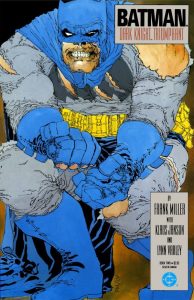
The Dark Knight Returns, written and illustrated by Frank Miller, told a much different story. An aging Batman is forced to come out of retirement to fight crime in a superhero-less Gotham City. The story is notable both for its adult themes and for the unusually dark and gritty art style. And while today the work is seen as revolutionary, at the time it was clearly controversial, given this New York Times Review:
“The stories are convoluted, difficult to follow and crammed with far too much text. The drawings offer a grotesquely muscle-bound Batman and Superman, not the lovable champions of old. My oldest son, an expert in these matters, has suggested that the inspiration is not so much the old comic book as rock videos. I think he’s right. If this book is meant for kids, I doubt that they will be pleased. If it is aimed at adults, they are not the sort I want to drink with.” (Richler, 1987)
But despite the initial backlash, The Dark Knight Returns went on to be one of the most influential comics of its time, redefining Batman and comic books as a whole for a generation. It can be found at the top of many “best graphic novel” lists, usually battling Watchmen for first place.
***
The year is 2000 and the entire history I am about to tell you is over and done with. I am in 9th grade, still a nerd, still a comic book reader, but my heydays of collecting are in a lull. It is not until now, 15 years after The Dark Knight Returns is published, that I first read it.
Living in Washington state at the time, I was browsing a now defunct Borders bookstore with my mom. I saw a copy of The Dark Knight Returns on the shelf and was curious about it. I had heard of it and recognized the iconic cover, but had never had the chance to actually look through it. My mom was in a generous mood and was willing to let me buy something, so I picked it up.
When I got home, I opened up the comic and was immediately immersed in it like no other comic before it. TDKR was unlike anything I had ever read. The characters were truly dark (opposed to the way modern comics only echoed), the colors were muted, the overall look was the definition of gritty. The story of this old and grizzled Batman drew me in and I did not put it down until I was finished. I was reading this book 15 years after its original publication (in a comic world heavily influenced by that very comic) and I was blown away. I can only imagine what The Dark Knight Returns was like when it was first released.
***
Watchmen, released during 1986 and 1987, is now considered not just one of the best comics published, but also one of the best novels. Created by Alan Moore and Dave Gibbons, Watchmen is most notable for the deconstruction of the superhero genre. Of the many costumed characters, only one (the big blue, often naked, Dr. Manhattan) possesses superhuman powers. Yes, there is the typical end-of-the-world stuff, but the characters must also deal with very adult themes, such as sexual assault and war.
The art of Watchmen is also noteworthy, often being tackled using simplistic 9-panel page layouts. In many ways, the art is a rejection of big, splashy representations of superheros. Instead, a deeply profound story is told (and told beautifully) using the most basic comic book structure possible.
Much like The Dark Knight Returns, Watchmen is credited with maturing the comic book medium by tackling bigger and darker themes. For better or for worse, the two series undeniably shifted the comic world toward its “grim and gritty” future.
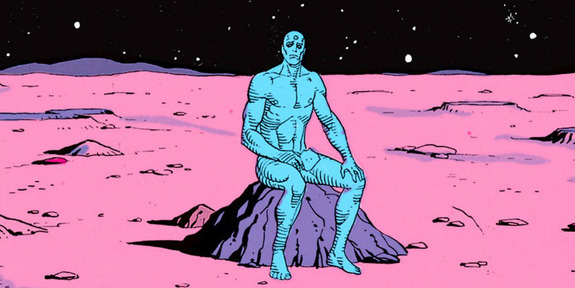
***
It’s 2005, I am a sophomore in college, and I still feel guilty about never reading Watchmen. Having been obsessed with comic books my whole life, the series was my holy grail of must reads, but I had yet to get around to it. Perhaps it was due to not having money or that it was always easier to pick up Spider-Man or X-Men, but it took me nearly 20 years to finally read Watchmen.
In college at the University of Washington, I discovered the library owned many influential comic book classics like Maus and Sandman. It was a perfect (and free) way for me to finally catch up on what I had been missing. My first stop there, I checked out Kingdom Come (the Alex Ross/Mark Waid masterpiece) and Watchmen.
My girlfriend at the time and I often read comics together, because yeah, we were gross. Sitting there, I asked her which of the two she would like to read first. She mentioned offhand how Watchmen seemed sort of boring and wanted to read Kingdom Come. I didn’t think twice of the matter, so we read Kingdom Come. A few weeks later, when I opened my birthday present, her choice became clear. She had already purchased me a copy of Watchmen.
The first time I read Watchmen I had a drastically different experience than that of The Dark Knight Returns. Watchmen did not hook me. I did not initially “get” why it was so popular. It was a lot to take in and at times it honestly felt boring. I thought maybe I couldn’t truly appreciate Watchmen 20 years after its publication, that the comic book world had been influenced by its presence too much. But I reread the work a couple years later and was blown away by its depth. I realized it is one of those comics that get better with each read, a comic that takes some time to truly appreciate. And now each time I read it, I “get” more of it and have grown to love it.
***
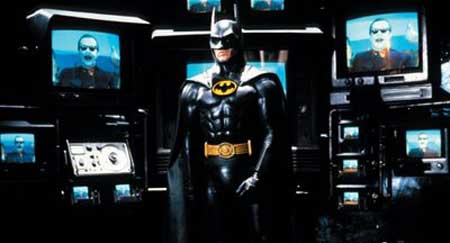
Just a couple years after the blockbuster releases of The Dark Knight Returns and Watchmen, mainstream attention was again brought to the comic book world with Tim Burton’s Batman. The 1989 film, starring Michael Keaton and Jack Nicholson, was both a financial and critical success. Yet the film’s role in establishing the birth of modern comics is often forgotten.
Much like The Dark Knight Returns, Batman took a darker approach to the character than previous incarnations. Sure, the film is undeniably Tim Burton with all of his usual bizarre tones and themes, but there was an uncommon edge associated with Batman that hadn’t been seen in mass media until now. Nicholson’s Joker isn’t just goofy, but also downright disturbing. Gotham City is a dark, twisted city that needs to be saved by a brooding Batman.
The Dark Knight Returns and Watchmen cemented a shift in the comic book world, but Batman did it for the mainstream audience. In the following years, the comic book world changed forever. All-ages characters became grim and gritty. Anti-heroes were on the rise. And most importantly, comics were cool again.
Rise of the Speculators
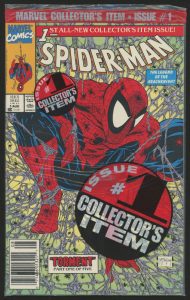
This new status quo in comics caught the attention of speculators hoping to turn a profit. With the resurgence in comic book popularity, historically valuable issues (first appearances of famous characters like Superman and Spider-Man) were selling at higher prices, not uncommonly for thousands of dollars. Hoping to catch the next big thing, speculators began buying up any modern comic they thought might hold the same value in the future.
This trend was not lost on the publishing world. It wasn’t long until comic book publishers began to cater to the speculator market directly. If the industry wanted to drive up sales, then they had to produce comics that appeared valuable to collectors. The simplest way to do this was to launch a new comic book series with a big fancy “#1” on the issue.
Thus, in 1990, Marvel released Spider-Man #1, a new series by popular writer/artist Todd McFarlane. Marvel shamelessly marketed the issue as a “collector’s item” and placed it in a sealed polybag. This meant that you could only read the issue if you broke the seal, in theory devaluing the comic. It is thought that this was a ploy by Marvel to have readers purchase more than one copy, one for collecting and one for reading. If that wasn’t enough, Marvel also published multiple variant covers. Whether it was due to marketing, speculation, or general curiosity, Spider-Man #1 became the best selling comic book in history, reportedly selling over 3 million copies.
***
Spider-Man has always been my favorite superhero. Sure, Peter Parker is the classic nerd that most comic book readers relate to, but I loved everything about the character. His costume is classic (both the traditional and black version), he has one of the best rogue galleries, and Spider-Man is just downright fun. As you can imagine, Spider-Man #1 was something I wanted.
Of course, at the tender age of 4 years old, I was not able to get my copy of Spider-Man #1 upon release. I had to wait until fifth grade and a trip to Paradox Comics and Cards. There, digging through some back issues, I noticed they had a copy selling for $12. Being only 10 years old, $12 was an amazing amount of money to spend on a single comic book, especially one with an original cover price of only $1.75. But I already had issues two through five and really needed that first one to complete the set. So I purchased it. Not understanding basic economics, I justified the purchase by thinking the comic would only increase in value. How could it not!?
A quick eBay search shows that I could buy Spider-Man #1 today for around $2.
Oddly enough, Spider-Man #1 is still one of my favorite comics. Todd MacFarlane’s art is amazing and the story is surprisingly good compared to its contemporaries. But most of all it brings me back to a bygone era of early 90s Spider-Man before it all went off a cheesy cliff.
***
In the comic book world, if something is successful, you beat it into the ground. With the sales success of Spider-Man #1, it wasn’t long until they started to launch more “adjectiveless” titles. The next year, Marvel released X-Men #1, hoping to catch the same magic as the new Spider-Man series. You could say it worked.
The new series combined the prolific Uncanny X-Men scribe Chris Claremont with then up-and-coming artist Jim Lee (transitioning over from Uncanny himself). The first issue was marketed with an unprecedented five variant covers, one to be released each week for five weeks. The first four covers would form one large image, while the fifth cover would feature a foldout montage of that same image. Hype was through the roof.
X-Men #1 preorders exceeded 8.5 million copies, making it the best selling comic of all time, a record it still holds to this day. Unfortunately, retailers had problems selling all of the issues they ordered. One comic book retailer recounts his experience:
“The week #1a came into the shop it was like a feeding frenzy at the zoo. I had over 10 boxes full of just one comic, when my standard weekly delivery normally consisted of 2 or 3 boxes with everything in. I had people three deep at the counter buying five copies of this first issue. We sold 75% of them in the first week. #1b arrived a week later and you could see the tumbleweed sweeping across the shop floor. […]I had a cellar full of X-Men #1s. I knew of fellow shop owners that had even more.” (Hall, 2011)
There was a perception by speculators that #1a was the true first issue and that the rest were reprints (which was true). Thus, after the first wave of purchases, the other “#1” issues held little interest to speculators, leaving comic book retailers with an incredible amount of excess stock. To make matters worse, three issues into X-Men, Claremont left the series and by issue #12 Jim Lee was gone as well.
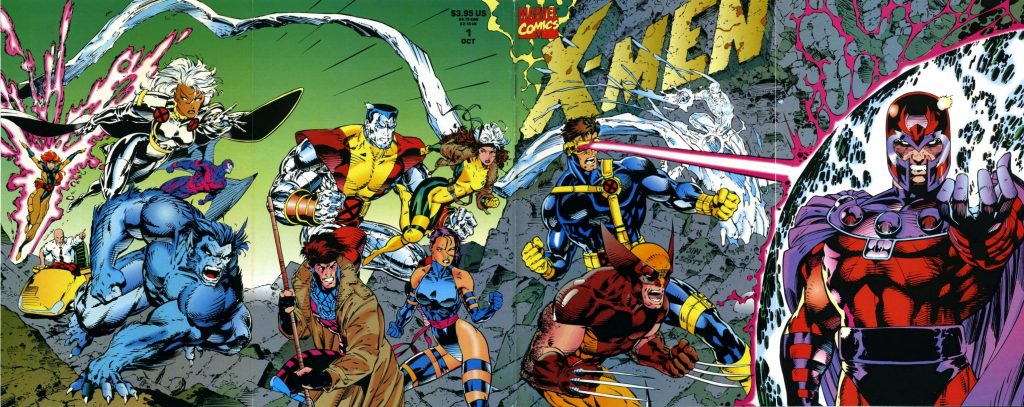
***
In contrast to my experience with Spider-Man #1, I didn’t come upon X-Men #1 until the other side of the speculator boom. In 10th grade, a friend of mine revealed he had a box of “old” comics he was looking to sell. Never one to pass up potential comics, I took a look.
The box was a microcosm of late 80s/early 90s comic books. There were classic Image titles like Spawn and Wildcats, the stuff that was “cool” at the time. There was a great run of Uncanny X-Men. And of course, there were all five variants of X-Men #1.
Few of these comics held any monetary value, but I still wanted them. It was like my youth in a box, but a weird alternate reality where I was really into X-Men as opposed to Spider-Man. I worked with my friend on a reasonable price and purchased the whole lot. Even so, I ended up paying cents on the dollar for most issues.
Signs of Trouble
Stress in the comic book industry were beginning to show. A major shift in readers following popular artists over writers led to many copycat artists and a de-emphasis on storytelling. Large volumes of comics were going unsold and quality was taking a backseat to gimmickry.
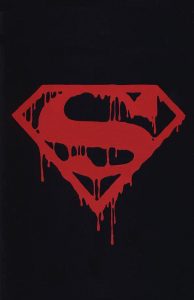
But it was not until 1993, with the release of Superman #75, that it is agreed that the market finally began to crash.
Superman #75 was heavily hyped as the culminating issue of the ongoing Death of Superman storyline. DC Comics promoted the event heavily, catching mainstream news and creating a major media spectacle. Readers unfamiliar with comics believed this was truly the end of Superman, thus a very important and valuable comic. Chuck Rozanski of Mile High Comics recounts his experience:
“People who had little, if any, previous interest in comics mobbed stores on the day that SUPERMAN #75 was released, some standing in line for hours to purchase just a single copy. […]There was only one problem with this entire program. It was based entirely on a lie. DC never had any intention of actually killing off Superman. His entire “death” was an event solely contrived to sell lots and lots of comic books.” (Rozanksi, 2004)
Another account of the day:
“Retailers couldn’t keep up with demand, and some hiked prices that day as high as $30 on the copies they had left. Price resistance was nowhere to be found, and customers unable to buy copies bought whatever else they could find. The few thousand retailers shared in what may well have been a $30 million day for the comics industry.” (CBGXtra.com, 2005)
***
Even at the tender age of 7 years old, I clearly remember The Death of Superman. It was a momentous event with plenty of media coverage. I specifically remember a piece on the evening news. The event was being covered as if Superman was never coming back. News reporters were on the scene (the scene being local comic book stores), images of Superman with ‘1938-1993’ displayed below, and reactions from customers.
As a kid, I was in awe. Comic books on the news! Superman was truly dying! It was unlike anything I had ever experienced.
The thing that stands out the most to me was that these comics were everywhere. Death of Superman comics weren’t just at your local comic book store, but also at Target and Walmart. I remember them being in grocery stores. This was unheard of at the time (or any time after) and it reinforced the point of just how important this event was.
By the time I managed to convince my parents to cough up some cash, Superman #75 was off the shelves, but I did get one of the follow-up issues (Adventures of Superman #501 with a die-cut cover) featuring a brand new Superboy. I was still young enough that I had my dad read it to me in bed. In an embarrassing moment, I remember my dad being shocked at what the comic was about (I no longer remember) and thinking it was not appropriate for my age. A sign of the darkening of comics…
Burst of the Bubble
After the sales success of Spider-Man, X-Men, and successful story lines such as the Death of Superman, companies tried to make every comic a potential collector’s item. Instead of focusing on quality storytelling, there was an explosion of gimmicky covers.
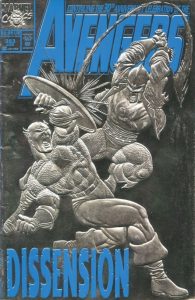
There were covers that glowed in the dark, die-cut covers, covers with holograms, foil-embossed covers, and even a cover that you could only see by placing a piece of paper on top and doing a rubbing. If it was something you could put on paper, comic book companies tried it on a cover, racing to the “first” at doing so. Books were literally judged by their covers.
***
As a kid, I ate up these silly gimmicks. A lot of my early collecting involved sitting on the floor of a comic book shop called Shinder’s in Minneapolis, Minnesota. I would beg my dad to take me to Shinder’s so I could look at comics. It was like Christmas. I would sit there in front of box after box of comics, searching for the best one. And when you are a kid who can only get one comic, the one’s with fancy covers say “buy me!”.
I managed to collect a few notably “90s” looking gimmicky comics: Fantastic Four #358 has a circle cut out to feature a giant 4 on the title page; Avengers #363 has an entirely silver foil-embossed cover; and X-Men Annual #17 is polybagged with a trading card. The thing that stands out to me now about these issues is that none of them are notably special beyond their covers. When I was a kid, I jumped at fancy covers and other gimmicks, but that is all they were. I often didn’t even read my comics, only picked up what looked “cool.” I wasn’t the only one.
***
Comic book companies realized that if an important story was happening, sales increased. These usually involved characters crossing over between series, landmark issues, or significant changes being made to an icon’s status quo. The problem with these events was that they often lacked quality storytelling and were instead motivated for the purpose of sales. Hey, Superman died? Let’s kill Batman now!
A prime example of the problem were a pair of Spider-Man stories from 1993-1996. Spider-Man had always been my favorite character, but during the 90s Spider-Man was always caught up in one gigantic story after another. For four months in 1993, a 14-part story called Maximum Carnage eclipsed all five Spider-Man titles. It featured just about every popular Spider-Man character at the time as well as guest stars from other comics. Yet even as a child I was frustrated, because I was never able to collect the complete story. In which Spider-Man comics did each part begin and end!? The crazy crossover drew me in, but the confusing nature of the story and publishing was a stark negative.
The following year the now infamous Clone Saga began in the Spider-Man titles. The story again spanned all of the Spider-Man titles attempting to reinvent the character. Initial sales were strong, so Marvel decided to stretch out the story as long as possible. Originally intended to be over within the year, the Clone Saga ran from October 1994 to December 1996. Editorial changes and a desire for sales turned the story into a convoluted mess that eventually turned off readers. The reaction was so poor that the ending reverted all of the changes made to Spider-Man and returned him to his status quo.
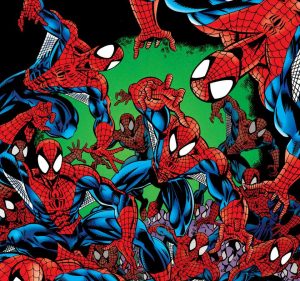
***
While I look back fondly on these Spider-Man stories, it is apparent why they were not healthy for the industry. For what seemed like ages to a young boy, every Spider-Man comic was about clones. Either you read about Spider-Man and his clones or you did not get to read Spider-Man.
In what has to be one of the weirdest, self-referential piece of comic book history, Marvel attempted to wrap-up the clone plotline with the story arc Maximum Clonage. A play on Maximum Carnage, I thought it was the most ridiculous thing as a kid. It had a gimmicky cover, a silly name, and it didn’t even conclude the story as promised. It was all of the 90s Spider-Man goofiness combined into a single (multi-issue) story.
***
The massive amounts gimmickry from publishers, and the false collectability they sought, began to take a toll on the industry. By early 1994 the market already began to waver. Starting in June, the market contracted by 10% each month. Comic book shops began shutting down, with one-third of all shops closing. The market was crashing.
Instead of shifting their focus on creating a quality product, companies continued with gimmicks in an attempt to stay afloat. Many smaller publishers that flourished in the bubble went out of business. Marvel made an unprecedented purchase of the third largest comic distributor to exclusively distribute Marvel comics. A legal distributor war followed, causing even more damage to the struggling industry. In 1996, half of all comic book shops had closed since the peak of the bubble. That same year Marvel filed for bankruptcy.
Aftermath and Signs of Life
Since the crash, the comic book industry has scaled back greatly in terms of books being published. In the late 90s and early 2000s, publishers’ bloated comic book lines had to be reduced to a more manageable size. This included the cancellation of many interconnected titles (Spider-Man, X-Men, Superman, etc. all had multiple series, many of which disappeared) as well as titles featuring lesser known characters.
The market today has somewhat stabilized, albeit at a drastically reduced output. The crash was catastrophic and new problems have risen since (the move to digital media and piracy). A comic today that cracks 100k issues sold is considered to be highly successful. Depending on the publisher, character, etc, a comic selling between 20k-50k is performing well. These numbers are significantly lower than those seen during the peak of the bubble.

Some positives have come out of the crash. An emphasis on quality storytelling has replaced the artistic hype that was prevalent in the 90s. Whereas before fans followed around their favorite artists despite the quality of story, writers have now taken the front seat. Many argue that comics are better than they have ever been.
The superhero film market has taken off as well. Since the release of the X-Men film in 2000, comic book inspired movies continue to come out and, for the most part, are very successful. Undeniably, the creation of the Marvel Cinematic Universe has changed the world of modern cinema. Whether or not this is helping the comic book industry is debatable.
But the comic book industry has not shed all of it’s past problems. Various gimmicks, while never truly gone, are more prominent than ever. Variant covers are still very popular as well as continuous relaunching of series to create an artificial boost in sales. There has even been the return of the sealed polybags. And while killing off big name heroes was the hot new thing in the 90s, it is now the status quo in comics today, with nearly every A-lister dying and resurrecting during the past 10 years.
While some of the similarities are concerning, it is yet to be seen whether or not another bubble is forming. The dramatic sale spikes of the previous bubble have not been witnessed (the closest occasion is most likely Amazing Spider-Man #583, featuring President Obama, selling over 350k copies). (ICv2.com, 2009) Readers complain online about “event fatigue” but sales numbers do not reflect that opinion. The extensive trade paperback market that has developed has actually helped stabilize readership. Only time will tell if lessons have truly been learned, but at this point the comic book world rests more on the fate of print media than anything else.
***
When I think of the speculation bubble in the 90s, I don’t think of all the mistakes companies were making or the way in which they were inflating sales. I think about how awesome it was to collect comic books. I think about Spider-Man and Venom and Carnage (and yes, even Clones). I think about the X-Men and Apocalypse and Onslaught. To me, these things weren’t something to review or critique, they were something to enjoy.
For older fans and retailers, I completely understand the bitterness towards those years. It’s undeniable that the comic book industry manipulated the public into believing in “collectability” and many stores went out of business because of it. Throughout my life time, it’s undeniably the biggest blemish on the comic book industry.
But nostalgia is a powerful force. Admittedly most of the comics I loved in the 90s don’t hold a candle to those today, but little-me loved them. When I look back on my 90s collecting, I think of the joy I had exploring different comic book stores. I think of my many friends with whom I shared my hobby with. I especially think of my parents, both who could have been embarrassed by their nerdy little kid but instead were more than willing to support my hobby.
I’m lucky enough to look back on the speculation bubble with a smile. Nonsensical crossovers and goofy covers merely remind me of simpler times. And while there are still echoes of those times in the industry today, the 90s aren’t (and shouldn’t be) repeatable. To me, they will always be that special, innocent time in a boy’s life where only what is in front of you matters. And more often than not, that was a comic book.
Works Cited
- 1900s: The Century in Comics. (2005). In CBGXtra. http://cbgxtra.com/knowledge-base/for-your-reference/the-1900s-the-century-in-comics.
- ‘Amazing Spider-Man’ #583 Sets Sales Record. (Feb. 17, 2009). http://www.icv2.com/articles/news/14314.html.
- Clone Saga. (2011). In Wikipedia. http://en.wikipedia.org/wiki/Clone_Saga.
- Comic Book Collecting. (2011). In Wikipedia. http://en.wikipedia.org/wiki/Comic_book_collecting.
- Dark Knight Returns. (2011). In Wikipedia. http://en.wikipedia.org/wiki/Batman:_The_Dark_Knight_Returns.
- Deppey, D. (November 10, 2002). The Fog Hollow Memorial Address . In The Comics Journal. http://archives.tcj.com/index.php?option=com_content&task=view&id=190&Itemid=70.
- Dietsch, T.J.. (June 29, 2010). The 12 Most Gimmick-y Gimmick Comic Covers of the ’90s. In Topless Robot. http://www.toplessrobot.com/2010/06/the_12_most_gimmick-y_gimmick_comic_covers_of_the.php.
- Hall, P. (May 9, 2011). My Monthly Curse by Phill Hall #9 – Taking Apart A Guinness World Record. In Bleeding Cool. http://www.bleedingcool.com/?p=77678.
- March 2011 Comic Book Sales Figures. (2011). In The Comics Chronicles. http://www.comichron.com/monthlycomicssales/2011/2011-03.html.
- Modern Age of Comic Books. (2011). In Wikipedia. http://en.wikipedia.org/wiki/Modern_Age_of_Comic_Books.
- Peter Parker: Spider-Man. (2011). In Wikipedia. http://en.wikipedia.org/wiki/Peter_Parker:_Spider-Man
- Richler, M. (May 3, 1987). PAPERBACKS; BATMAN AT MIDLIFE: OR THE FUNNIES GROW UP. In New York Times. http://www.nytimes.com/1987/05/03/books/paperbacks-batman-at-midlife-or-the-funnies-grow-up.html?src=pm.
- Rozanski, C. (2004). “Death of Superman” Promotion of 1992. In Mile High Comics. http://www.milehighcomics.com/tales/cbg127.html.
- SDCC 2010: Marvel Breaks World Record. (Aug. 10, 2010). In Marvel.com. http://marvel.com/news/story/13598/sdcc_2010_marvel_breaks_world_record.
- Watchmen. (2011). In Wikipedia. http://en.wikipedia.org/wiki/Watchmen.
- X-Men: Legacy. (2011). In Wikipedia. http://en.wikipedia.org/wiki/X-Men:_Legacy.
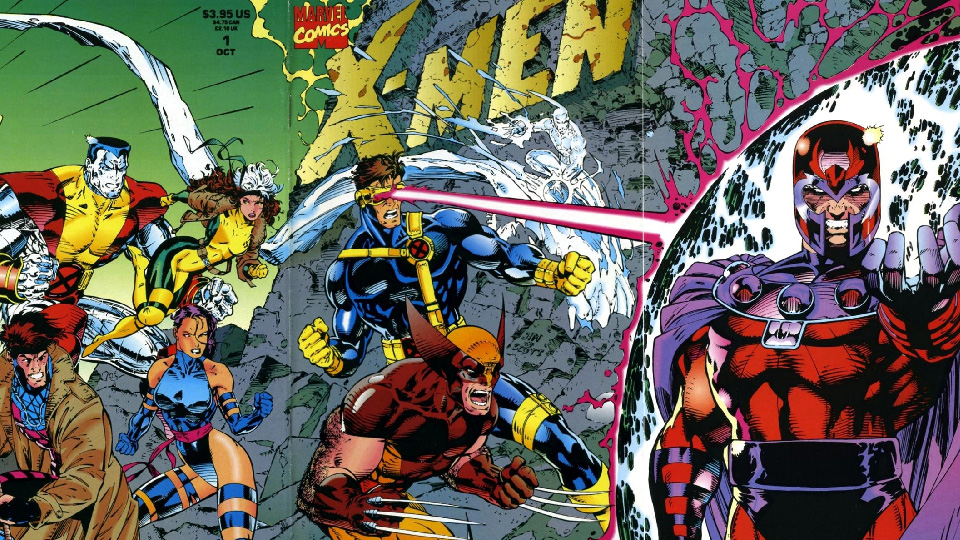
I read comics up until the gimmicky 90s. I still re-buy Archives in Kindle form. You should write about Valiant, Superman’s new powers, marrying Lois, the Marvel reboots, the Marvel-DC crossovers, the full page panels…
Too bad. EC Archives are affordable and the best.
You’re right that there is so much more that could have been discussed when it comes to comic books in the 90s. It’s amazing how much bizarre stuff was happening during that decade.